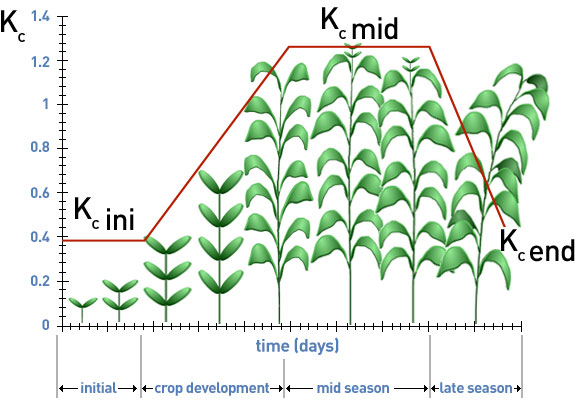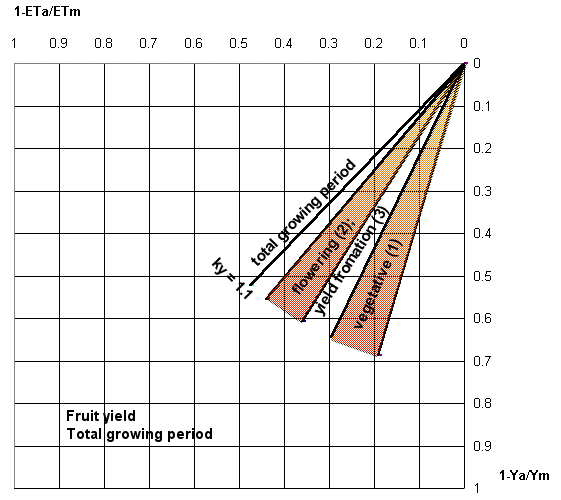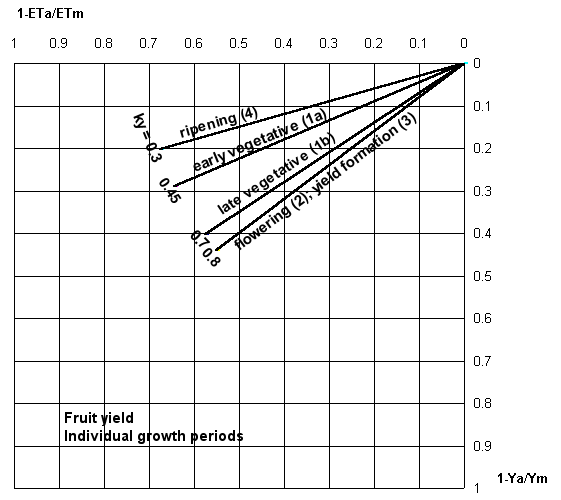Watermelon
This section presents information on water relations and water management of watermelon and provides links to other sources of information.
Crop Description and Climate
Crop Description and Climate
Watermelon (Citrullus vulgaris) is native to the dry areas in tropical and sub-tropical Africa south of the equator. The crop can survive the desert climate when groundwater is available and the fruit sometimes serves as a source of water for human consumption. World production is about 77.5 million tons fruit from 3.1 million ha.(FAOSTAT, 2001).
The crop prefers a hot, dry climate with mean daily temperatures of 22 to 30°C. Maximum and minimum temperatures for growth are about 35 and 18°C respectively. The optimum soil temperature for root growth is in the range of 20 to 35°C. Fruits grown under hot, dry conditions have a high sugar content of 11 percent in comparison to 8 percent under cool, humid conditions. The crop is very sensitive to frost. The length of the total growing period ranges from 80 to 110 days, depending on climate.
The crop prefers a sandy loam soil texture with pH of 5.8 to 7.2. Cultivation in heavy textured soils results in a slower crop development and cracked fruits. For high production fertilizer requirements are 80 to 100 kg/ha N, 25 to 60 kg/ha P and 35 to 80 kg/ha K.
The crop is moderately sensitive to salinity. Yield decrease due to salinity appears to be similar to that of cucumber, or: 0% at ECe 2.5 mmhos/cm, 10% at 3.3, 25% at 4.4, 50% at 6.3 and 100% at ECe 10 mmho s / cm .
Watermelon is normally seeded directly in the fields. Thinning is practised 15 to 25 days after sowing. Spacing between plants and rows varies from 0.6 x 0.9 to 1.8 x 2.4 m. Seeds are sometimes placed on hills spaced 1.8 x 2.4m. In areas prone to frost, sowing time is dictated often by the occurrence of frost; sometimes black plastic mulch is used for frost protection.
The graph below depicts the crop stages of watermelon, and the table summarises the main crop coefficients used for water management.

Stages of | Plant | Region | |||||
|---|---|---|---|---|---|---|---|
Crop | Initial | Crop | Mid-season | Late | Total |
| |
Stage length, | 20 | 30 | 30 | 30 | 110 | Apr | Italy |
Depletion Coefficient, p | - | - | - | - | 0.4 | ||
Root Depth, m | - | - | - | - | 0.8 | ||
Crop Coefficient,Kc | 0.4 | >> | 1.0 | 0.75 | - |
| |
Yield Response | 0.45 | 0.8 | 0.8 | 0.3 | 1.1 |
|
|
Water Requirements
Water Requirements
Under conditions of high evaporation, irrigation intervals may be as short as 6 to 8 days. For maximum production the crop coefficients (kc) relating water requirements (ETm) to reference evapotranspiration (ETo) are: during the 10 to 20 day initial stage, 0.4-0.5, during the 15 to 20 days development stage, 0.7-0.8; the 35 to 50 day mid-season stage 0.95-1.05; and the 10 to 15 day late-season stage, 0.8-0.9. After 70 to 105 days, at harvest, kc is 0.65-0. 75. Water requirements for the total growing period for a 100-day crop range from 400 to 600 mm.
Water Supply And Crop Yield
Water Supply And Crop Yield
The relationships between relative yield decrease (1 - Ya/Ym) and relative evapotranspiration deficit for the total growing period of watermelon are shown in the figure below.

This figure shows the relationships between relative yield decrease (1 - Ya/Ym) and relative evapotranspiration deficit for the individual growth periods.

The crop can deplete soil water to a soil water tension of over 2 atmospheres without the yield being affected. Irrigation should take place when, depending on the level of evaporation, the soil water has been depleted some 50 to 70 percent of available soil water. In dry climates with moderate evaporation and little rain the watermelon produces an acceptable yield (15 ton/ha) with one heavy irrigation in the beginning of the growing period when soil water over the full root depth is brought to field capacity.
The growth periods of a 80 to 110 day watermelon are: the establishment period (0) of 10 to 15 days; the vegetative period (1) of 20 to 25 days, including early (1a) and late vegetative growth (vine development, 1b); the flowering period of 15 to 20 days; yield formation (fruit filling, 3) of 20 to 30 days and ripening (4) 15 to 20 days. The crop usually has 4 fruits per plant, which is controlled by pruning practices, and harvest date depends on the number of fruits per plant and on uniformity of ripening.
The relationship between relative yield decrease and relative evapotranspiration deficit is given in Figure 50. Water deficit during the establishment period (0) delays growth and produces a less vigorous plant. When water deficit occurs during the early vegetative period (1a), less leaf area is produced which causes yield reduction. The late vegetative period (vine development, 1b), the flowering period (2) and the yield formation period (fruit filling, 3) are the most sensitive periods to water deficit. During the ripening period (4) a reduced water supply improves fruit quality. Yields are little affected by water deficits immediately prior to harvest.
Whereas under limiting conditions some water savings may be made during vegetative (1) and ripening (4) periods, water supply should be directed toward maximizing production per ha by meeting full crop water requirements rather than extending the cultivated area under limited supply.
Water Uptake
Water Uptake
Water uptake varies with soil type and irrigation practices. The root system can be deep and extensive up to a depth of 1.5 to 2m. The active root zone where most of the water is abstracted under adequate water supply is limited to the first 1.0 to 1.5 (D = 1.0-1.5m). Under moderate evapotranspiration (ETm is 5 to 6mm/day), the crop can deplete the available soil water up to 40 or 50 percent before ETm is affected (p = 0.4-0.5).
Irrigation Scheduling
Irrigation Scheduling
Where evaporation is high and rainfall is low, frequent irrigation with an interval from 7 to 10 days may be necessary. Irrigation under dry conditions must be scheduled at the start of the growing period (pre-irrigation), during the late vegetative period (vine development, 1b), the flowering period (2) and the yield formation period (3). In these periods soil water depletion must not exceed 50 percent. During the ripening period (4) relatively dry soils are preferred to increase sugar content and to avoid the flesh becoming more fibrous and less juicy.
Under moderate evaporation and deep soil with some rain during the growing season, one heavy irrigation may be sufficient to bring the crop to maturity.
Irrigation Methods
Irrigation Methods
The most common method is by furrow. Under conditions where crop water requirements are high and the soils are light textured, drip irrigation has been successfully applied with a reduction in overall water demands. The crop has been grown successfully under spate or flood irrigation on basins with one application of 250 to 350 mm and little or no rainfall and with farmers' yields of about 12 ton/ha with a maximum of 20 ton/ha.
Yield
Yield
Within certain water deficit limits, irrigation practices do not greatly affect the number of fruits per plant but affect the fruit size, shape, weight and quality. Ample water supply during the ripening period (4) reduces the sugar content and adversely affects the flavour. Severe water deficit in the ripening period on the other hand causes cracked and irregularly-shaped fruits.
A good commercial yield under irrigation is 25 to 35ton/ha. The water utilization efficiency for harvested yield (Ey) for fresh fruits containing about 90 percent moisture varies between 5 and 8kg/m3
